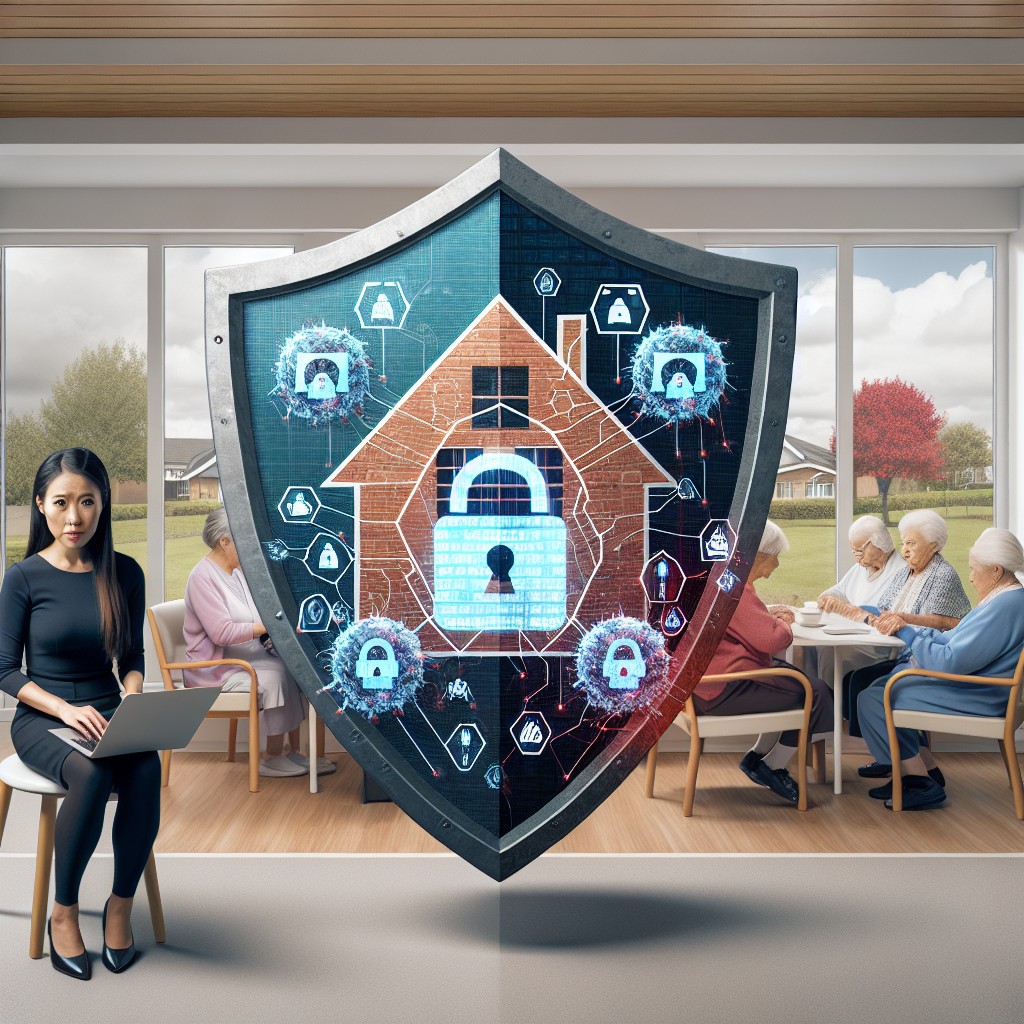Safeguarding Senior Care: Strategies to Defend Against Cyber Threats

In an increasingly digital world, the healthcare sector, particularly senior care, faces a growing threat from cybercriminals. As technology becomes more integrated into healthcare services, the risk of cyberattacks targeting sensitive patient data and critical systems escalates. This article explores the strategies necessary to defend against these cyber threats, ensuring the safety and privacy of senior care facilities and their residents.
Understanding the Cyber Threat Landscape in Senior Care
The senior care sector is a prime target for cybercriminals due to the sensitive nature of the data it handles and the often outdated technology systems in use. Understanding the specific threats faced by this sector is crucial for developing effective defense strategies.
Types of Cyber Threats
Senior care facilities face a variety of cyber threats, each with its own set of challenges and potential impacts. These threats include:
- Ransomware Attacks: These attacks involve malicious software that encrypts data, rendering it inaccessible until a ransom is paid. Senior care facilities are particularly vulnerable due to their reliance on electronic health records.
- Phishing Scams: Cybercriminals use deceptive emails or messages to trick employees into revealing sensitive information or downloading malware.
- Data Breaches: Unauthorized access to sensitive patient data can lead to identity theft and financial fraud.
- Insider Threats: Employees or contractors with access to sensitive information may intentionally or unintentionally compromise data security.
- IoT Vulnerabilities: The increasing use of Internet of Things (IoT) devices in healthcare introduces new vulnerabilities that can be exploited by cybercriminals.
Case Studies of Cyber Attacks in Senior Care
Several high-profile cyberattacks have highlighted the vulnerabilities in the senior care sector. For example, in 2019, a ransomware attack on a major senior care provider resulted in the temporary shutdown of its IT systems, affecting thousands of residents. This incident underscored the need for robust cybersecurity measures.
Another case involved a phishing attack that compromised the personal information of hundreds of residents in a senior living community. The attackers gained access to sensitive data, including Social Security numbers and medical records, leading to significant financial and reputational damage.
The Impact of Cyber Threats on Senior Care
The consequences of cyberattacks on senior care facilities can be severe, affecting not only the organizations themselves but also the residents they serve. These impacts include:
- Financial Losses: The costs associated with recovering from a cyberattack can be substantial, including ransom payments, legal fees, and the expense of implementing new security measures.
- Reputational Damage: A data breach can erode trust among residents and their families, leading to a loss of business and long-term damage to the facility’s reputation.
- Operational Disruptions: Cyberattacks can disrupt critical healthcare services, potentially compromising patient safety and care quality.
- Legal and Regulatory Consequences: Senior care facilities may face legal action and regulatory penalties if they fail to adequately protect patient data.
Statistics on Cyber Threats in Healthcare
According to a report by the Ponemon Institute, the healthcare sector experiences more data breaches than any other industry, with an average cost of $7.13 million per breach. Additionally, a survey by HIMSS found that 70% of healthcare organizations had experienced a significant security incident in the past year, highlighting the pervasive nature of cyber threats in this sector.
The Importance of Cybersecurity in Senior Care
Given the sensitive nature of the data handled by senior care facilities and the potential consequences of a cyberattack, cybersecurity must be a top priority. Protecting patient data and ensuring the continuity of care are essential for maintaining trust and delivering high-quality services.
Implementing Robust Cybersecurity Measures
To effectively defend against cyber threats, senior care facilities must implement comprehensive cybersecurity measures. This involves a combination of technology, policies, and training to create a secure environment for both residents and staff.
Developing a Cybersecurity Framework
A well-defined cybersecurity framework provides a structured approach to managing cyber risks. This framework should include:
- Risk Assessment: Regularly assess the facility’s vulnerabilities and potential threats to identify areas for improvement.
- Security Policies: Establish clear policies and procedures for data protection, access control, and incident response.
- Technology Solutions: Implement advanced security technologies, such as firewalls, intrusion detection systems, and encryption, to protect sensitive data.
- Monitoring and Auditing: Continuously monitor network activity and conduct regular audits to detect and respond to potential threats.
- Incident Response Plan: Develop a comprehensive plan for responding to cyber incidents, including communication strategies and recovery procedures.
Investing in Advanced Security Technologies
Technology plays a critical role in defending against cyber threats. Senior care facilities should invest in advanced security solutions to protect their networks and data. Key technologies include:
- Encryption: Encrypt sensitive data both in transit and at rest to prevent unauthorized access.
- Multi-Factor Authentication (MFA): Implement MFA to add an extra layer of security for accessing systems and data.
- Endpoint Protection: Deploy endpoint protection solutions to safeguard devices from malware and other threats.
- Network Segmentation: Segment networks to limit the spread of malware and restrict access to sensitive data.
- Security Information and Event Management (SIEM): Use SIEM systems to collect and analyze security data, enabling rapid detection and response to threats.
Training and Educating Staff
Human error is a significant factor in many cyber incidents. Training and educating staff on cybersecurity best practices is essential for reducing the risk of breaches. Key training initiatives include:
- Phishing Awareness: Educate employees on how to recognize and respond to phishing attempts.
- Password Management: Promote the use of strong, unique passwords and encourage regular password changes.
- Data Handling Practices: Train staff on proper data handling procedures to prevent unauthorized access and data leaks.
- Incident Reporting: Encourage employees to report suspicious activity or potential security incidents promptly.
- Regular Training Sessions: Conduct ongoing training sessions to keep staff informed about the latest cybersecurity threats and best practices.
Collaborating with Cybersecurity Experts
Partnering with cybersecurity experts can provide senior care facilities with valuable insights and resources for enhancing their security posture. These experts can assist with:
- Security Assessments: Conducting thorough assessments to identify vulnerabilities and recommend improvements.
- Incident Response: Providing support during cyber incidents to minimize damage and facilitate recovery.
- Security Strategy Development: Assisting in the development of comprehensive cybersecurity strategies tailored to the facility’s needs.
- Training Programs: Offering specialized training programs to educate staff on cybersecurity best practices.
- Technology Implementation: Helping to implement and configure advanced security technologies.
Ensuring Compliance with Regulations
Compliance with healthcare regulations, such as the Health Insurance Portability and Accountability Act (HIPAA), is critical for protecting patient data and avoiding legal penalties. Senior care facilities must ensure that their cybersecurity measures align with these regulations by:
- Conducting Regular Audits: Perform regular audits to assess compliance with regulatory requirements.
- Documenting Security Policies: Maintain comprehensive documentation of security policies and procedures.
- Implementing Access Controls: Restrict access to sensitive data based on job roles and responsibilities.
- Ensuring Data Integrity: Implement measures to ensure the accuracy and integrity of patient data.
- Reporting Breaches: Establish procedures for reporting data breaches to regulatory authorities promptly.
Building a Culture of Cybersecurity Awareness
Creating a culture of cybersecurity awareness within senior care facilities is essential for maintaining a strong defense against cyber threats. This involves fostering a mindset where security is a shared responsibility among all staff members.
Leadership Commitment to Cybersecurity
Leadership plays a crucial role in establishing a culture of cybersecurity awareness. Senior management must demonstrate a commitment to security by:
- Allocating Resources: Providing the necessary resources for implementing and maintaining robust cybersecurity measures.
- Setting Expectations: Clearly communicating the importance of cybersecurity and setting expectations for staff behavior.
- Leading by Example: Demonstrating good cybersecurity practices in their own actions and decisions.
- Encouraging Open Communication: Fostering an environment where staff feel comfortable reporting security concerns or incidents.
- Recognizing and Rewarding Good Practices: Acknowledging and rewarding staff who demonstrate strong cybersecurity practices.
Integrating Cybersecurity into Daily Operations
To build a culture of cybersecurity awareness, facilities must integrate security practices into their daily operations. This can be achieved by:
- Regular Security Briefings: Conducting regular briefings to update staff on the latest threats and security measures.
- Incorporating Security into Onboarding: Including cybersecurity training as part of the onboarding process for new employees.
- Encouraging Security Discussions: Promoting discussions about cybersecurity during team meetings and other forums.
- Implementing Security Checklists: Using checklists to ensure that security measures are consistently applied in daily tasks.
- Monitoring Compliance: Regularly monitoring compliance with security policies and procedures.
Empowering Employees with Knowledge
Empowering employees with the knowledge and skills to recognize and respond to cyber threats is essential for building a culture of cybersecurity awareness. This can be achieved through:
- Ongoing Training Programs: Providing regular training sessions to keep staff informed about the latest threats and best practices.
- Access to Resources: Offering access to resources, such as online courses and webinars, to enhance cybersecurity knowledge.
- Encouraging Self-Education: Encouraging employees to stay informed about cybersecurity trends and developments.
- Providing Support and Guidance: Offering support and guidance to employees who have questions or concerns about cybersecurity.
- Creating a Cybersecurity Champions Program: Identifying and training staff members to serve as cybersecurity champions within their teams.
Promoting a Security-First Mindset
Promoting a security-first mindset involves encouraging staff to prioritize security in all aspects of their work. This can be achieved by:
- Encouraging Vigilance: Encouraging staff to remain vigilant and report any suspicious activity or potential threats.
- Emphasizing the Importance of Security: Regularly reinforcing the importance of cybersecurity in protecting patient data and ensuring the continuity of care.
- Highlighting Real-World Examples: Using real-world examples and case studies to illustrate the potential consequences of cyber threats.
- Fostering a Sense of Responsibility: Encouraging staff to take personal responsibility for their role in maintaining cybersecurity.
- Celebrating Security Successes: Celebrating successes and achievements in cybersecurity to reinforce positive behavior.
Measuring the Effectiveness of Cybersecurity Awareness Programs
Measuring the effectiveness of cybersecurity awareness programs is essential for ensuring their success. This can be achieved by:
- Conducting Surveys and Assessments: Regularly surveying staff to assess their knowledge and awareness of cybersecurity threats and best practices.
- Tracking Incident Reports: Monitoring the number and nature of security incidents reported by staff.
- Evaluating Training Outcomes: Evaluating the outcomes of training programs to identify areas for improvement.
- Analyzing Security Metrics: Analyzing security metrics, such as the number of successful phishing attempts, to assess the effectiveness of awareness programs.
- Gathering Feedback: Gathering feedback from staff to identify areas where additional support or resources may be needed.
Leveraging Technology to Enhance Cybersecurity
Technology plays a critical role in enhancing cybersecurity in senior care facilities. By leveraging advanced technologies, facilities can better protect their networks and data from cyber threats.
The Role of Artificial Intelligence in Cybersecurity
Artificial intelligence (AI) is increasingly being used to enhance cybersecurity by automating threat detection and response. AI can help senior care facilities by:
- Identifying Anomalies: Using machine learning algorithms to identify unusual patterns of behavior that may indicate a cyber threat.
- Automating Threat Response: Automating the response to certain types of threats, reducing the time it takes to mitigate them.
- Enhancing Threat Intelligence: Analyzing large volumes of data to identify emerging threats and trends.
- Improving Incident Response: Providing real-time insights and recommendations to improve incident response efforts.
- Reducing False Positives: Reducing the number of false positives by improving the accuracy of threat detection.
The Benefits of Cloud Security Solutions
Cloud security solutions offer several benefits for senior care facilities, including:
- Scalability: Cloud solutions can easily scale to meet the changing needs of the facility.
- Cost-Effectiveness: Cloud solutions often have lower upfront costs compared to on-premises solutions.
- Enhanced Security: Cloud providers often have advanced security measures in place to protect data.
- Improved Collaboration: Cloud solutions facilitate collaboration by allowing staff to access data and applications from anywhere.
- Automatic Updates: Cloud solutions are automatically updated with the latest security patches and features.
The Importance of Network Security
Network security is a critical component of cybersecurity in senior care facilities. Key network security measures include:
- Firewalls: Firewalls help protect networks by blocking unauthorized access and filtering traffic.
- Intrusion Detection Systems (IDS): IDS monitor network traffic for signs of suspicious activity.
- Virtual Private Networks (VPNs): VPNs provide secure remote access to the facility’s network.
- Network Segmentation: Segmenting networks helps contain the spread of malware and limit access to sensitive data.
- Regular Network Audits: Conducting regular audits helps identify vulnerabilities and areas for improvement.
The Role of Endpoint Security
Endpoint security is essential for protecting devices used by staff and residents. Key endpoint security measures include:
- Antivirus Software: Antivirus software helps detect and remove malware from devices.
- Device Encryption: Encrypting devices helps protect data in the event of loss or theft.
- Patch Management: Regularly updating software and operating systems helps protect against known vulnerabilities.
- Mobile Device Management (MDM): MDM solutions help manage and secure mobile devices used by staff.
- Access Controls: Implementing access controls helps restrict access to sensitive data and applications.
The Future of Cybersecurity in Senior Care
The future of cybersecurity in senior care will be shaped by emerging technologies and evolving threats. Key trends to watch include:
- Increased Use of AI and Machine Learning: AI and machine learning will play a larger role in threat detection and response.
- Greater Focus on IoT Security: As IoT devices become more prevalent, securing these devices will be a top priority.
- Expansion of Cloud Security Solutions: Cloud security solutions will continue to evolve, offering new features and capabilities.
- Emphasis on Zero Trust Architecture: Zero trust architecture will become more common, focusing on verifying every user and device.
- Increased Collaboration with Cybersecurity Experts: Facilities will increasingly collaborate with cybersecurity experts to enhance their security posture.
Conclusion: A Comprehensive Approach to Cybersecurity in Senior Care
Safeguarding senior care facilities against cyber threats requires a comprehensive approach that combines technology, policies, and education. By understanding the cyber threat landscape, implementing robust security measures, building a culture of cybersecurity awareness, and leveraging advanced technologies, senior care facilities can protect their networks and data from cybercriminals. As the threat landscape continues to evolve, it is essential for facilities to remain vigilant and proactive in their cybersecurity efforts, ensuring the safety and privacy of their residents and maintaining trust in their services.
The key takeaways from this article include the importance of understanding the specific cyber threats faced by senior care facilities, the need for a comprehensive cybersecurity framework, the role of leadership in fostering a culture of cybersecurity awareness, the benefits of leveraging advanced technologies, and the importance of compliance with healthcare regulations. By adopting these strategies, senior care facilities can effectively defend against cyber threats and ensure the safety and well-being of their residents.





